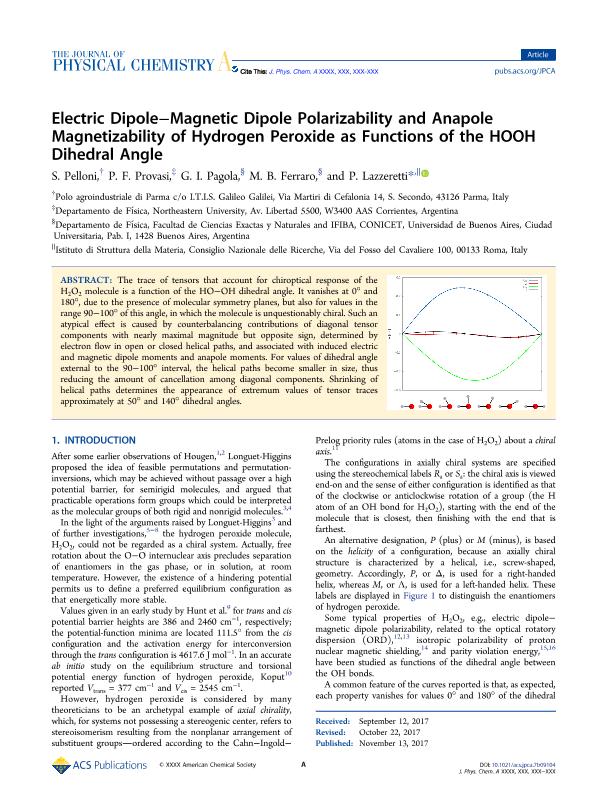Artículo
Electric Dipole-Magnetic Dipole Polarizability and Anapole Magnetizability of Hydrogen Peroxide as Functions of the HOOH Dihedral Angle
Pelloni, Stefano; Provasi, Patricio Federico ; Pagola, Gabriel Ignacio
; Pagola, Gabriel Ignacio ; Ferraro, Marta Beatriz
; Ferraro, Marta Beatriz ; Lazzeretti, Paolo
; Lazzeretti, Paolo
 ; Pagola, Gabriel Ignacio
; Pagola, Gabriel Ignacio ; Ferraro, Marta Beatriz
; Ferraro, Marta Beatriz ; Lazzeretti, Paolo
; Lazzeretti, Paolo
Fecha de publicación:
12/2017
Editorial:
American Chemical Society
Revista:
Journal of Physical Chemistry A
ISSN:
1089-5639
Idioma:
Inglés
Tipo de recurso:
Artículo publicado
Clasificación temática:
Resumen
The trace of tensors that account for chiroptical response of the H2O2 molecule is a function of the HO-OH dihedral angle. It vanishes at 0° and 180°, due to the presence of molecular symmetry planes, but also for values in the range 90-100° of this angle, in which the molecule is unquestionably chiral. Such an atypical effect is caused by counterbalancing contributions of diagonal tensor components with nearly maximal magnitude but opposite sign, determined by electron flow in open or closed helical paths, and associated with induced electric and magnetic dipole moments and anapole moments. For values of dihedral angle external to the 90-100° interval, the helical paths become smaller in size, thus reducing the amount of cancellation among diagonal components. Shrinking of helical paths determines the appearance of extremum values of tensor traces approximately at 50° and 140° dihedral angles.
Palabras clave:
Anapoles
,
Magnetic Properties
,
Chirality
,
Magnetic Dipole Moment
Archivos asociados
Licencia
Identificadores
Colecciones
Articulos(IFIBA)
Articulos de INST.DE FISICA DE BUENOS AIRES
Articulos de INST.DE FISICA DE BUENOS AIRES
Articulos(IMIT)
Articulos de INST.DE MODELADO E INNOVACION TECNOLOGICA
Articulos de INST.DE MODELADO E INNOVACION TECNOLOGICA
Citación
Pelloni, Stefano; Provasi, Patricio Federico; Pagola, Gabriel Ignacio; Ferraro, Marta Beatriz; Lazzeretti, Paolo; Electric Dipole-Magnetic Dipole Polarizability and Anapole Magnetizability of Hydrogen Peroxide as Functions of the HOOH Dihedral Angle; American Chemical Society; Journal of Physical Chemistry A; 121; 48; 12-2017; 9369-9376
Compartir
Altmétricas



